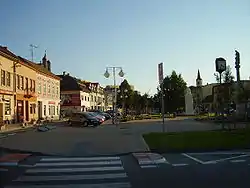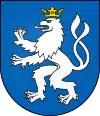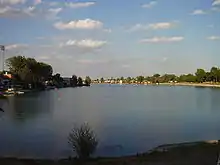Senec, Slovakia
Senec (Hungarian: Szenc) is a town in the Bratislava Region of south-western Slovakia. It is a well known summer tourism and recreation center. The town is attractive not only because of the proximity of Bratislava, the capital of Slovakia, but also because of the healthy environment and summer resort "Slnečné jazerá" ("Sunny Lakes").
Senec Szenc | |
|---|---|
Town | |
 Town centre of Senec | |
 Coat of arms | |
 Senec Szenc Location of Senec in the Bratislava Region  Senec Szenc Senec Szenc (Slovakia) | |
| Coordinates: 48°13′08″N 17°23′59″E | |
| Country | Slovakia |
| Region | Bratislava |
| District | Senec |
| First mentioned | 1252 |
| Government | |
| • Mayor | Dušan Badinský |
| Area | |
| • Total | 38.714 km2 (14.948 sq mi) |
| Elevation | 137 m (449 ft) |
| Population (2018-12-31[1]) | |
| • Total | 19,711 |
| • Density | 510/km2 (1,300/sq mi) |
| Time zone | UTC+1 (CET) |
| • Summer (DST) | UTC+2 (CEST) |
| Postal code | 903 01 |
| Area code(s) | +421-2 |
| Car plate | SC |
| Website | www.senec.sk |
Name
The name comes from a Slavic appellative seno: hay (the inhabitants dealt with cattle trade, see also Senica, Senné, Veľký Krtíš District or Senné, Michalovce District).[2] 1252 Zemch, 1451 Sencz.[2] A German historic name was Wartberg.
History
In the 9th century, the territory of Senec became part of the Kingdom of Hungary. In the second half of the 15th century, Hungarian king Matthias Corvinus gave Senec privileges and it got the right of organizing a fair around 1480. In the 19th century, it started to develop after the Pressburg - Budapest railway which runs through the town had been built. After the Austro-Hungarian army disintegrated in November 1918, Czechoslovak troops occupied the area, later acknowledged internationally by the Treaty of Trianon. Between 1938 and 1945 Senec once more became part of Miklós Horthy's Hungary through the First Vienna Award. In 1945, it was recovered by Czechoslovakia. A number of residents were affected by the Beneš Decrees and 630 rich and intellectual citizens of Hungarian nationality of Senec were forced to leave the town in 1947 to Hungary. This was a part of ethnic cleansing in Czechoslovakia.[3] From 1945 until the Velvet Divorce, it was part of Czechoslovakia. Since then it has been part of Slovakia.
The historic Church of Saint Nicholaus is located in the southwestern part of the town.
Geography

Senec is situated in Podunajská nížina, on the boundary line of Podunajská rovina and Podunajská pahorkatina. The town is 27 km far from the Austrian boundary (frontier crossing at Kittsee), and 28 km far from the border with Hungary (frontier crossing at Rajka). Vienna (90 km), Budapest (230 km) and Prague (350 km) are the nearest European capitals.[4]
The town is located 25 kilometres north-east from Bratislava, 126 m above sea level. It has good access to the motorway D1 from Bratislava to Žilina, and is situated on the significant 4th Corridor of Trans-European Transport Network Railway route Prague–Bratislava–Balkans/Orient.[4]
The town consists of four boroughs (Senec, Svätý Martin, Červený majer and Horný dvor).
Demographics
In 2001 14,673 permanent residents lived in Senec and the population density was 379/km². Accordingly, Senec ranks at the 55th place among 138 Slovak cities and towns. Following the age, 67.5% inhabitants are in the productive age (men 15–59 years old, women 15–54 years old).
77% occupants acknowledged Slovak nationality and 22% Hungarian nationality. The Roman Catholic Church dominates with 71.7% within the religious structure. The Protestant Church with 8.45% is the second largest Church. The residents without faith represent 12.89%.
In education, technical and secondary schools without the General Certificate of Education dominate with 27.91%. In 2001 graduates represented 11.17% share of Senec residents.[4]
Twin towns — sister cities
Asteroid
Asteroid 20664 Senec was named in honor of the Slovakian town.[6] The official naming citation was published by the Minor Planet Center on 25 September 2018 (M.P.C. 111797).[7]
See also
References
- "Population and migration". Statistical Office of the Slovak Republic. Retrieved 2019-04-16.
- Krajčovič, Rudolf (2005). Živé kroniky slovenských dejín [Living Chronicles of the Slovak History] (in Slovak). Bratislava: Literárne informačné centrum. pp. 216–217. ISBN 80-88878-99-3.
- Popély Árpád: Lakosságcsere és reszlovakizáció, 2002, page 471
- http://www.senec.sk/index.php?id=106&lang=1
- "História mesta" (in Slovak). Senec. Retrieved 2019-09-03.
- "20664 Senec (1999 UV4)". Minor Planet Center. Retrieved 17 October 2018.
- "MPC/MPO/MPS Archive". Minor Planet Center. Retrieved 17 October 2018.